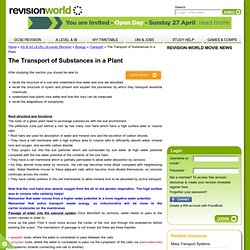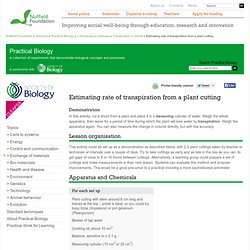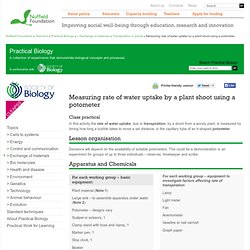

a2-level-level-revision, biology, transport, transport-substances-plant. After studying this section you should be able to: recall the structure of a root and understand how water and ions are absorbed recall the structure of xylem and phloem and explain the processes by which they transport essential chemicals understand how plants lose water and how this loss can be measured recall the adaptations of xerophytes Root structure and functions The roots of a green plant need to exchange substances with the soil environment.

The piliferous zone just behind a root tip has many root hairs which have a high surface area to volume ratio. • Root hairs are used for absorption of water and mineral ions and the excretion of carbon dioxide. • They have a cell membrane with a high surface area to volume ratio to efficiently absorb water, mineral ions and oxygen, and excrete carbon dioxide. • They project out into the soil particles which are surrounded by soil water at high water potential compared with the low water potential of the contents of the root hairs. Casparian strip. Estimating rate of transpiration from a plant cutting.
In this activity, cut a shoot from a plant and place it in a measuring cylinder of water.

Weigh the whole apparatus, then leave for a period of time during which the plant will lose water by transpiration. Weigh the apparatus again. You can also measure the change in volume directly, but with low accuracy. This activity could be set up as a demonstration as described below, with 2-3 plant cuttings taken by teacher or technician at intervals over a couple of days. Try to take cuttings as early and as late in the day as you can, to get gaps of close to 8 or 16 hours between cuttings. Plant cutting with stem around 8 cm long and leaves at the top – privet is ideal, or you could try busy lizzie (Impatiens) or pot geranium (Pelargonium) Beaker of tap water Cooking oil, about 10 cm3 Balance, sensitive to ± 0.1 g Measuring cylinder (10 cm3 or 25 cm3) Teat pipette, 2 Scissors Sellotape Trays (Note 1) Some students may be allergic to or suffer skin irritation in contact with plant sap. Measuring rate of water uptake by a plant shoot using a potometer. In this activity the rate of water uptake, due to transpiration, by a shoot from a woody plant, is measured by timing how long a bubble takes to move a set distance, in the capillary tube of an h-shaped potometer.

Decisions will depend on the availability of suitable potometers. This could be a demonstration or an experiment for groups of up to three individuals – observer, timekeeper and scribe. For each working group – equipment to investigate factors affecting rate of transpiration: Lamp Light meter Fan Anemometer Vaseline or nail varnish Graph paper. Transpiration: Introduction. Transpiration by Theresa Knapp Holtzclaw © 1998, Peregrine Publishers, Inc.

All Rights Reserved. Development Team Transpiration is the major mechanism that drives the movement of water through a plant. In the first section of this laboratory you will investigate factors that influence the rate of transpiration. In the second section you will study plant anatomy as it relates to transport. To do this laboratory, you should understand the basic concepts of water potential. LabBench. Transpiration. Transpiration (Science Mag) Animation - Phloem Loading.